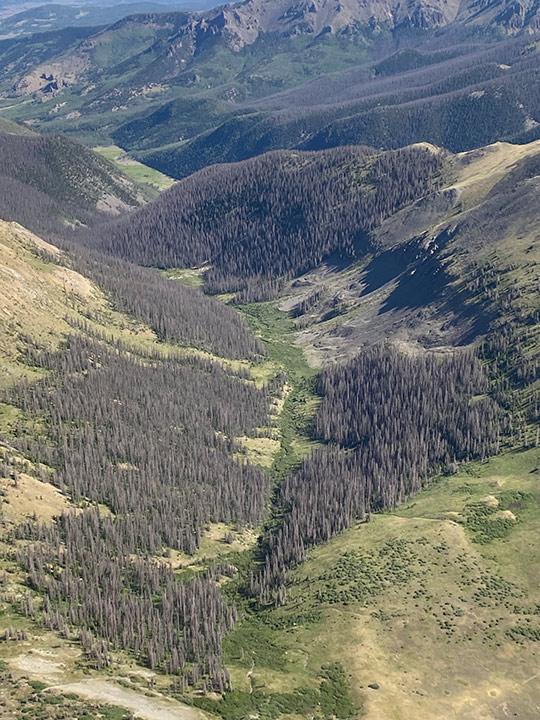Forest managers are working together to address continued outbreaks of insects and disease in Colorado’s forests, including the spruce beetle, which remains the most damaging forest pest in the state for the ninth consecutive year, based on a 2020 aerial detection survey led by the USDA Forest Service, Rocky Mountain Region, and Colorado State Forest Service.
Every year, the agencies aerially monitor forest health conditions on millions of forested acres across the state. Today, the agencies released the results of last year’s aerial survey and survey map.
Due to pandemic safety protocols in 2020, trained aerial observers with the USFS and CSFS flew over priority areas where there was a likelihood of forest pests causing widespread tree mortality. In total, they monitored 16.3 million acres from the air, compared to 30.2 million acres in 2019. Because of the reduced acreage observed, total numbers of affected acres are not included in the findings or in the forthcoming 2020 Report on the Health of Colorado’s Forests since comparisons between 2020 and other years are not possible.
Despite the modified flights, observers were able to detect and track pests infesting areas of forests that were previously unaffected, including the spruce beetle and Douglas-fir beetle. While the intensity of these two native bark beetles decreased in 2020, they continue to infest and kill previously unaffected stands.
The spruce beetle affects high-elevation Engelmann spruce. Primary areas impacted by this insect include newly infested forests in eastern Gunnison and western Chaffee counties. Both counties are experiencing severe, intense infestations. Spruce beetle populations also increased in Hinsdale, San Juan and La Plata counties. Beetle outbreaks in Huerfano and Custer counties continue to expand as well, though not as rapidly. In Grand County, the intensity of infestations has declined from past years as the beetle continuously depletes large-diameter spruce trees. Since 2000, the spruce beetle has affected at least 1.88 million forested acres in Colorado.
The Douglas-fir beetle continued to invade Douglas-fir trees in central and southern Colorado, particularly in Gunnison, Saguache, Hinsdale and Mineral counties, where infestations are severe.
Weather continues to play an important role in creating conditions that exacerbate the activity of spruce and Douglas-fir beetles, as well as other forest pests, in Colorado. The amount of precipitation and daily temperature patterns affect how well trees can ward off pests to remain healthy and resilient. In 2020, winter and spring had average precipitation amounts. Thereafter, severe and extreme drought conditions across most of the state occurred through the summer and fall, further weakening trees and intensifying infestations of bark beetles and other forest pests.

“Unfortunately, our dry conditions are optimal for insect epidemics and tree diseases in many parts of the Rocky Mountains,” said Tammy Angel, Acting Regional Forester for the USDA Forest Service, Rocky Mountain Region. “Where possible, managing forests for age and species diversity can increase resiliency while ensuring diverse wildlife habitat, cleaner air and water, timber and grazing resources, and greener, safer landscapes for recreation.”
Spurred by drought conditions, the roundheaded pine beetle and associated native bark beetles continue to affect ponderosa pine forests in Dolores and La Plata counties in southwest Colorado. The intensity of this activity remains high in localized areas of the San Juan National Forest. Further to the south, pockets of affected areas within La Plata County are expanding.
The aerial survey also revealed that western spruce budworm continues to be Colorado’s most damaging and widespread forest defoliator. Budworm infested forests in south-central Colorado continue to experience intense disturbance. Over several years, defoliation from this insect may weaken a tree to the point where bark beetles can easily overcome the tree and kill it.
“Colorado’s forests are vital to the economic and ecological health of our state,” said Mike Lester, state forester and director of the Colorado State Forest Service. “Our partnership with the USDA Forest Service on the aerial survey offers another great example of how we can effectively address forest health issues that span property boundaries by working together, like bark beetle outbreaks. With information from the survey, we better understand the health of our forests and can focus our efforts where they’ll make the biggest impact.”
The aerial survey exemplifies the agencies’ continued support for shared stewardship and the Memorandum of Understanding signed in 2019, which establishes a framework for federal and state agencies to work collaboratively to accomplish mutual goals and respond to ecological, natural resource, and recreational challenges and concerns for the 24.4 million acres of forestlands in Colorado.
For more results from the 2020 aerial survey, including a map of insect and disease activity in Colorado, please visit bit.ly/COForestHealth2020.

